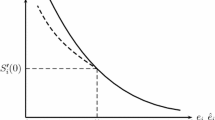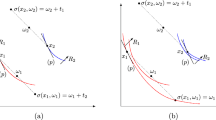Abstract
The analysis of trade-restricting policies under uncertainty has typically argued in favour of the specific tariff over alternative commercial policies such as the ad valorem tariff and the quota, when the raising of revenue and maintenance of consumer's welfare are the policy objectives. This paper reconsiders this result. It is demonstrated that, when the shape of the welfare probability distribution is considered explicitly, the quota may be the dominant trade-restricting policy. In addition, the analysis of trade-restricting instruments is analysed for the case where the principle of safety-first is applied to the revenue-raising objective.
Similar content being viewed by others
References
E. R. Arzac (1976): Profits and Safety in the Theory of the Firm under Price Uncertainty, International Economic Review17, pp. 163–171.
P. Dasgupta and J. E. Stiglitz (1977): Tariffs Versus Quotas as Revenue-Raising Devices under Uncertainty, American Economic Review67, pp. 975–981.
D. G. Dickinson, M. J. Driscoll, and J. L. Ford (1980): Tariffs Versus Quotas as Revenue-Raising Devices under Uncertainty, Discussion Paper No. 249, Department of Economics, University of Birmingham.
D. G. Dickinson, M. J. Driscoll, and J. L. Ford (1982): Protection, the Value of Imports and Optimal Trade-Restricting Policies, Weltwirtschaftliches Archiv118, No. 2, pp. 317–331.
M. J. Driscoll and J. L. Ford (1983): Protection and Optimal Trade-Restricting Policies under Uncertainty, Manchester SchoolLI, pp. 21–32.
G. Fishelson and F. Flatters (1975): The (non-)equivalence of Tariffs and Quotas under Uncertainty, Journal of International Economics5, pp. 385–393.
M. D. Pelcovits (1976): Quotas Versus Tariffs, Journal of International Economics6, pp. 363–370.
A. D. Roy (1952): Safety-First and the Holding of Assets, Econometrica20, pp. 431–449.
C. Vastrup (1979): The Choice Between a Tariff and a Quota under Uncertainty, Weltwirtschaftliches Archiv115, pp. 729–735.
L. Young (1980a): Optimal Revenue-Raising Trade-Restrictions under Uncertainty, Journal of International Economics10, pp. 425–439.
L. Young (1980b): Tariffs Versus Quotas under Uncertainty: an Extension, American Economic Review70, pp. 522–527.
L. Young and J. E. Anderson (1980): The Optimal Policies for Restricting Trade under Uncertainty, Review of Economic StudiesXLVI, pp. 927–932.
Author information
Authors and Affiliations
Additional information
We should like to thank an anonymous referee for helpful comments on an earlier draft.
Rights and permissions
About this article
Cite this article
Dickinson, D.G., Driscoll, M.J. & Ford, J.L. Revenue raising trade-restricting policies under uncertainty: The sub-optimality of the expected welfare criterion and some safety-first results. Zeitschr. f. Nationalökonomie 44, 387–403 (1984). https://doi.org/10.1007/BF01283370
Received:
Revised:
Issue Date:
DOI: https://doi.org/10.1007/BF01283370




